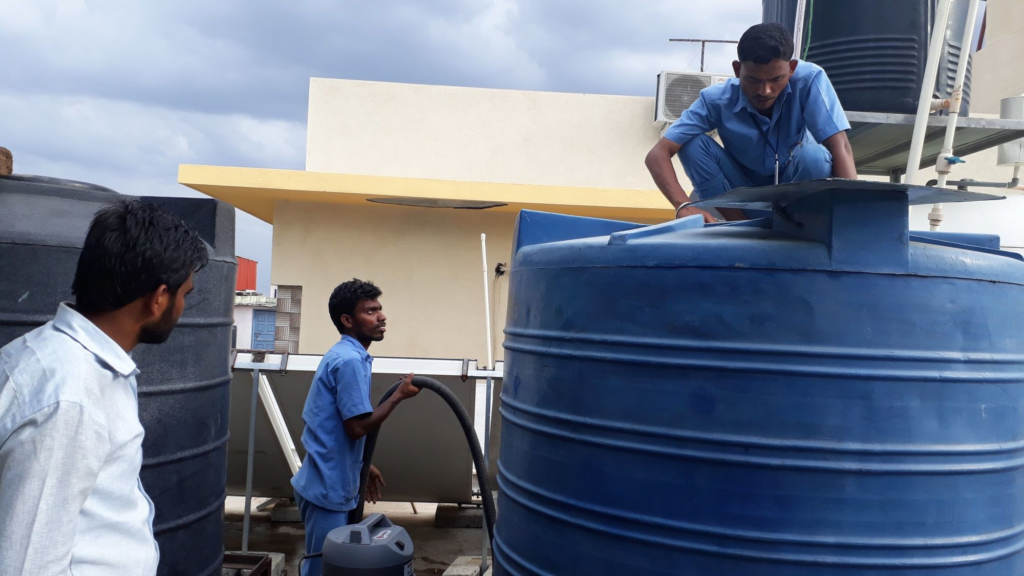Water storage tanks play a vital role in homes, businesses, and industries. They ensure a consistent supply of water for drinking, cleaning, and other essential uses. However, over time, these tanks can accumulate dirt, algae, bacteria, and other contaminants that may affect the quality of the water. To maintain clean and safe water, regular tank cleaning is essential.
In this blog, we will explore the best methods for cleaning water storage tanks, the tools you’ll need, and the steps to take to ensure your tank is thoroughly cleaned.
Why Is Cleaning Your Water Storage Tank Important?
Water storage tanks are constantly exposed to environmental factors that can contaminate the water stored inside. Here are a few reasons why cleaning your tank is important:
- Health Safety: Contaminated water can lead to serious health problems, including gastrointestinal issues and waterborne diseases.
- Water Quality: Dirt, debris, and algae can affect the taste, smell, and color of the water.
- Tank Longevity: Regular cleaning prevents rust, scaling, and other issues that may damage the tank.
- Efficient Operation: Clean tanks ensure an uninterrupted flow of water and proper functioning of the connected systems.
Note: Ensure a healthier water supply for your home or business! Contact us today for professional water storage tanks cleaning services and enjoy clean, safe, and hygienic water. Don’t wait – book now!
How Often Should You Clean Your Water Tank?

Cleaning frequency depends on various factors, such as the tank’s location, usage, and type of water being stored. Generally, it is recommended to clean your water storage tank at least once every six months. If the tank is exposed to extreme weather conditions or is storing non-potable water, cleaning it more frequently might be necessary.
Tools and Equipment Needed for Cleaning Water Tanks
Before diving into the cleaning process, it’s important to have the right tools and equipment. Here is a list of essentials:
- Safety Gear: Gloves, boots, goggles, and a face mask.
- Cleaning Brushes: Long-handled brushes for scrubbing the tank walls and floor.
- Pump or Siphon Hose: To remove water and sludge from the tank.
- Water Supply: Clean water for rinsing and refilling the tank.
- Bleach or Disinfectant: To kill bacteria and other harmful microorganisms.
- Torch or Flashlight: For better visibility inside the tank.
- Bucket and Mop: For manual cleaning if required.
- Ladder: To access large or elevated tanks.
Step-by-Step Guide to Cleaning Your Water Storage Tank
Here’s a simple yet effective guide to cleaning your water storage tank:
Step 1: Prepare for Cleaning
- Turn Off the Water Supply: Shut off the inlet and outlet valves to prevent water flow during cleaning.
- Drain the Tank: Use a pump or siphon hose to remove the water. Ensure all the water is drained out before proceeding.
- Inspect the Tank: Check for visible cracks, leaks, or other damages. Repair these issues before continuing.
Step 2: Remove Sludge and Debris
- Use a shovel or bucket to remove large debris or settled sludge at the bottom of the tank.
- Use a vacuum pump if available for efficient sludge removal.
Step 3: Scrub the Interior
- Using long-handled brushes, scrub the walls and floor of the tank to remove dirt and algae.
- Pay extra attention to corners and hard-to-reach areas.
- Avoid using abrasive tools that may damage the tank’s surface.
Step 4: Disinfect the Tank
- Prepare a solution of bleach or a suitable disinfectant. Typically, one cup of bleach for every 50 gallons of water works well.
- Apply the disinfectant to the interior surfaces using a sprayer or mop.
- Let the disinfectant sit for 15-30 minutes to kill bacteria and germs.
Step 5: Rinse the Tank
- Rinse the tank thoroughly with clean water to remove all traces of the cleaning solution.
- Repeat the rinsing process several times to ensure no residue is left behind.
Step 6: Dry the Tank
- Allow the tank to air-dry completely. This step helps prevent the growth of mold and mildew.
- Use a clean cloth to wipe down any remaining moisture if needed.
Step 7: Refill the Tank
- Once the tank is dry, refill it with clean water.
- Turn the water supply back on and test the system to ensure everything is functioning properly.
Best Practices for Maintaining a Clean Water Tank
Regular cleaning is essential, but following these best practices can help keep your water tank cleaner for longer:
1. Install a Tank Cover
A tightly fitting lid or cover prevents dirt, leaves, and other debris from entering the tank. It also keeps out insects and small animals.
2. Use a Water Filter
Install a filtration system at the inlet to remove impurities before water enters the tank. This reduces the buildup of sediment and contaminants.
3. Avoid Direct Sunlight
Position your tank in a shaded area or use a UV-resistant cover to minimize algae growth caused by sunlight.
4. Conduct Regular Inspections
Inspect your tank monthly for any signs of dirt, leaks, or contamination. Early detection can save you time and money.
5. Use Safe Cleaning Products
Always use cleaning agents that are safe for water storage tanks and won’t leave harmful residues.
Common Mistakes to Avoid During Tank Cleaning
Cleaning a water storage tank may seem straightforward, but certain mistakes can compromise the process. Here are a few to avoid:
- Using Harsh Chemicals: These can damage the tank and leave harmful residues.
- Skipping Disinfection: Simply scrubbing the tank isn’t enough; disinfection is crucial.
- Neglecting Rinse Steps: Residual cleaning agents can contaminate the water.
- Cleaning Without Safety Gear: Always prioritize your safety by wearing gloves, goggles, and a mask.
- Ignoring Repairs: Cleaning a damaged tank without fixing it first can lead to leaks and water contamination.
Professional Tank Cleaning Services: When to Call the Experts
While DIY cleaning is manageable for small tanks, larger or more complex systems may require professional help. Consider hiring experts if:
- The tank is too large to clean manually.
- There are stubborn stains or heavy sludge buildup.
- You don’t have the proper tools or cleaning agents.
- You’re dealing with underground or rooftop tanks.
- Regular maintenance has been neglected for a long time.
Professional services often use advanced equipment, such as high-pressure jets and industrial vacuums, to clean tanks thoroughly and efficiently.
Conclusion
Keeping your water storage tank clean is essential for ensuring the safety and quality of your water supply. By following the best practices and cleaning steps outlined in this guide, you can maintain a clean and hygienic tank that serves your needs effectively.
Remember, regular cleaning, proper maintenance, and timely inspections are key to avoiding contamination and extending the life of your tank. If the task feels overwhelming, don’t hesitate to seek professional assistance. Clean water starts with a clean tank—make it a priority!
For more insightful articles related to this topic, feel free to visit kyalu.in
Also Read
- ► The Benefits Of Chopper Machine In Daily Life
- ► Expert Tips for Finding the Best MARA Agent in Australia
- ► DG Club Login Benefits – Why Logging in Daily Boosts Your Gaming Experience
- ► Yellow Stone Jacket: Your Next Must-Have Style Upgrade
- ► How Much Does a Logo Design Cost?
- ► Room – 30cm Rustic Wooden Sign
- ► Troubleshooting Lancia Cars and How to Fix Common Issues
- ► The Top Reasons to Pursue FDA Certification
- ► Find Your Dream Home at Kohinoor Bhugaon Pune 2, 3, 4 BHK Flats on Paud Road
- ► Fildena – Revive Confidence, Restore Intimacy
- ► Nanotechnology Market: Unlocking Innovation Across Industries
- ► Why Investment in Mutual Funds Is a Smart Financial Choice
- ► Boost Your Social Media Engagement with a Cheap SMM Panel
- ► Why Choosing the Best Preschool in Gurgaon Matters for Your Child’s Future
- ► Navigating the Rental Market Sound Advice for Landlords





